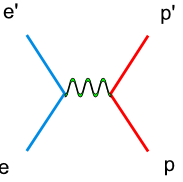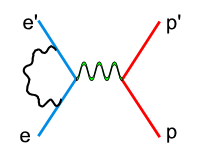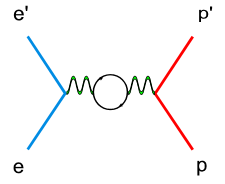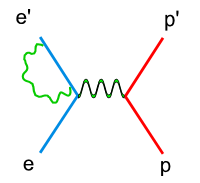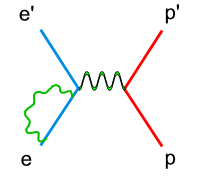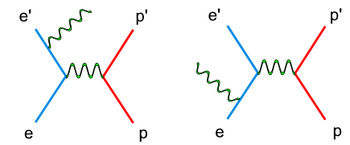Difference between revisions of "Tamar AppendixChapt"
(Created page with ' [https://wiki.iac.isu.edu/index.php/Delta_D_over_D Back to DeltaD]') |
|||
| Line 1: | Line 1: | ||
| + | =Radiative Corrections= | ||
| + | In double spin asymmetry analysis the electron nucleon scattering process is given as an one photon exchange event, so called the Born approximation([https://wiki.iac.isu.edu/images/f/f2/TheBornApproximation.png Fig 2.19]). In reality, there are multiple photon effects during the experiments. These high order processes, also called radiative effects, can be calculated and used to correct the cross section data.<br> | ||
| + | {| border="0" style="background:transparent;" align="center" | ||
| + | |- | ||
| + | | | ||
| + | [[File:TheBornApproximation.png|350px|thumb|'''Figure 2.19.''' The Born Approximation]] | ||
| + | |}<br> | ||
| + | There are two types of radiative corrections, internal and external. Internal radiative corrections describe the contributions, which took place during the lepton-hadron interaction. In first order approximation they include vertex photon exchange, self energy and vacuum polarization Fig. 2.20.<ref name="RadiativeCorrections"> Nucleon Form Factors. In Scholarpedia, from http://www.scholarpedia.org/article/Nucleon_Form_factors#History </ref><br> | ||
| + | {| border="2" align="center" | ||
| + | |- | ||
| + | |[[File:InetranRadiativeCor1.png|350px|thumb|Vertex Photon Exchange]]|| [[File:InetranRadiativeCor2.png|350px|thumb|Vacuum Polarization]] | ||
| + | |- | ||
| + | |[[File:InetranRadiativeCor3.png|350px|thumb|Self Energy]]|| [[File:InetranRadiativeCor4.png|350px|thumb|Self Energy]] | ||
| + | |}<br> | ||
| + | {| border="2" align="center" | ||
| + | |- | ||
| + | |'''Figure 2.20''' Internal Radiation | ||
| + | |}<br> | ||
| + | On the other hand, the external radiative corrections account for the Bremsstrahlung by the incoming and scattered electron and by the recoiling target nucleon [https://wiki.iac.isu.edu/images/0/04/ExternalRadiativeCor.png Fig. 2.21].<br> | ||
| + | {| border="0" style="background:transparent;" align="center" | ||
| + | |- | ||
| + | | | ||
| + | [[File:ExternalRadiativeCor.png|350px|thumb|'''Figure 2.21''' Externall Radiation]] | ||
| + | |}<br> | ||
| + | One of the major advantages of the double polarization experiments is the minimum contribution from the radiative corrections. For the <math>~4.2 GeV</math> incident electron beam data the radiative corrections are less than 5%<ref>http://www.jlab.org/Hall-B/secure/eg1/EG2000/fersch/QUALITY_CHECKS/file_quality/runinfo.txt</ref>. Due to negligible contributions from the radiative corrections, they are not included in the double spin asymmetry analysis.<br> | ||
[https://wiki.iac.isu.edu/index.php/Delta_D_over_D Back to DeltaD] | [https://wiki.iac.isu.edu/index.php/Delta_D_over_D Back to DeltaD] | ||
Revision as of 17:32, 15 June 2012
Radiative Corrections
In double spin asymmetry analysis the electron nucleon scattering process is given as an one photon exchange event, so called the Born approximation(Fig 2.19). In reality, there are multiple photon effects during the experiments. These high order processes, also called radiative effects, can be calculated and used to correct the cross section data.
There are two types of radiative corrections, internal and external. Internal radiative corrections describe the contributions, which took place during the lepton-hadron interaction. In first order approximation they include vertex photon exchange, self energy and vacuum polarization Fig. 2.20.<ref name="RadiativeCorrections"> Nucleon Form Factors. In Scholarpedia, from http://www.scholarpedia.org/article/Nucleon_Form_factors#History </ref>
| Figure 2.20 Internal Radiation |
On the other hand, the external radiative corrections account for the Bremsstrahlung by the incoming and scattered electron and by the recoiling target nucleon Fig. 2.21.
One of the major advantages of the double polarization experiments is the minimum contribution from the radiative corrections. For the incident electron beam data the radiative corrections are less than 5%<ref>http://www.jlab.org/Hall-B/secure/eg1/EG2000/fersch/QUALITY_CHECKS/file_quality/runinfo.txt</ref>. Due to negligible contributions from the radiative corrections, they are not included in the double spin asymmetry analysis.
